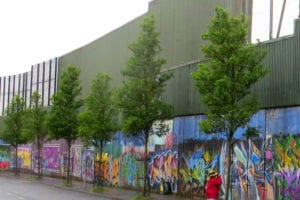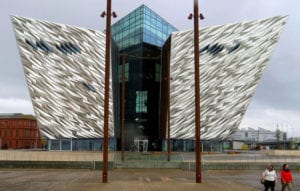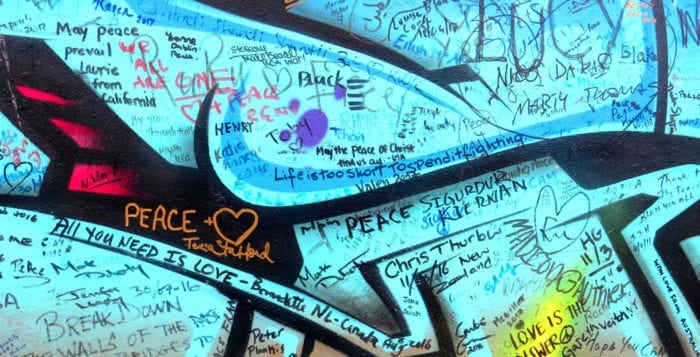By Beverly C. Tyler
After two weeks in the Republic of Ireland, my wife and I arrived in Belfast, Northern Ireland, for a tour around the city. For the next two and a half hours we looked at, photographed and listened to our tour guide tell us about Belfast sights including the memorials, statues and paintings on walls in both the Catholic and Protestant areas of Belfast.
It is easy to judge from the murals painted on the walls in both Catholic and Protestant areas that little has changed in attitudes and positions concerning the divisions that existed before the peace (in 2007) that stopped most of the violence. However, there are examples of new murals calling for harmony and brotherhood in both sectarian areas that are replacing the many militant murals that have, for a long time, promoted hate, distrust and fear. There are also a number of memorial gardens commemorating those killed during the Troubles, as the fighting in Northern Ireland for more than three decades is identified.

The fences and gates dividing the two sides are still there, but there are no restrictions on driving through any area except that some gates between Catholic and Protestant areas are still closed at night, according to our tour guide and confirmed by many reports and websites. In the Shankill Road area, a so-called peace wall separating Catholic and Protestant communities, originally constructed to keep the peace between factions, now contains many thousands of personal messages of goodwill and unity. The wall is topped by corrugated steel panels, which in turn are topped by steel screens or fence that appear to be about 40 feet high. Erected during the Troubles, there is no indication that these walls, dividing the population of Belfast both physically and culturally, are to be removed any time soon.
Belfast, as well as much of Ireland, both north and south, has an economy based in large part on tourism. After experiencing the sectarian divide in Belfast, our tour took us to the Titanic Quarter. An area that was once a thriving shipbuilding area and then a deteriorating industrial site is now an area of high-rise condos, an entertainment center and the impressive Titanic Experience, opened in 2012, inside the area known as Titanic Belfast.
Before our tour, we were given personal multimedia electronic guides with headsets that help guide visitors through the four floors of Titanic Experience. The tour starts with the history of Belfast especially detailing the rise of the linen industry through factory work and the history of shipbuilding in Belfast that culminates in the building of the Titanic.
The Titanic Experience has a total of nine interpretive and interactive galleries that expose you to the sights, sounds, smells and stories of the RMS Titanic from its building to its launching and fitting out. It continues as you move from floor to floor with Titanic’s shakedown cruise in 1912, picking up and discharging passengers in two ports and heading across the Atlantic. The experience gets more dramatic as the ship hits the iceberg, and we hear the official messages transmitted and received as well as the oral histories of surviving passengers.

As we explored the twists and turns of the galleries, we reached the gallery where we saw the ship sinking and the efforts of the crew and passengers to get off the ship. We were provided a number of stories of individuals on the ship including the captain, the ship’s designer and stories of first-, second- and third-class passengers. Then we saw the reactions of media and officials, the boards of inquiry and in brief detail the many movies made about the Titanic, mostly showing how they had romanticized the tragic events. Another section detailed the graveyards in places like Halifax, Nova Scotia, where many of the recovered bodies are buried.
The last part of the Titanic Experience, on a theater-sized screen, is the story of the discovery of the wreck of the Titanic in 1985 by Robert Ballard and his team. We watched their dramatic film of the two separated sections of the Titanic 12,000 feet below the surface and the debris field that trailed out behind the ship. It was this debris field that provided Ballard with the ability to locate the Titanic.
The last experience, below the giant screen, under a glass floor, is film taken from above the Titanic. You see the Titanic below as you stand on the glass floor and watch as the sunken ship passes beneath your feet.
Outside the Titanic Experience, the building itself is a dramatic creation of both the Titanic’s massive hull and the iceberg that ended its life and the lives of its many passengers and crew. Within the area covered by Titanic Belfast are the Titanic’s Dock and Pump House, the SS Nomadic — the last remaining White Star vessel, and a Discovery Tour that includes the drawing offices where Titanic was created and the slipways where she was built.
We left Belfast for our afternoon ride to Dublin, Republic of Ireland, and our next morning departure. Goodbye, Northern Ireland, sláinte!
Beverly C. Tyler is Three Village Historical Society historian and author of books available from the society at 93 North Country Road, Setauket. For more information, call 631-751-3730 or visit www.tvhs.org.





